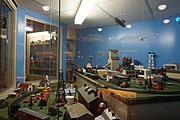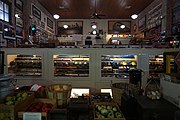
Tyler is a city in and the county seat of Smith County, Texas, United States. As of 2020, the population is 105,995. Tyler was the 38th most populous city in Texas and 289th in the United States. It is the principal city of the Tyler metropolitan statistical area, which is the 198th most populous metropolitan area in the U.S. and 16th in Texas after Waco and the College Station–Bryan areas, with a population of 233,479 in 2020. The city is named for John Tyler, the tenth President of the United States.

Dallas Union Station, officially Eddie Bernice Johnson Union Station, also known as Dallas Union Terminal, is a large intermodal railroad station in Dallas, Texas. It is the third busiest Amtrak station in Texas, behind Fort Worth Central Station and San Antonio station. It serves DART Light Rail Blue and Red lines, Trinity Railway Express commuter rail and Amtrak intercity rail. It is located on Houston Street, between Wood and Young Streets, in the Reunion district of Downtown Dallas. The structure is a Dallas Landmark and is listed on the National Register of Historic Places.
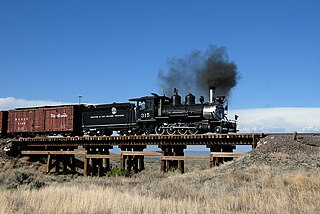
Conservation and restoration of rail vehicles aims to preserve historic rail vehicles. It may concern trains that have been removed from service and later restored to their past condition, or have never been removed from service, like UP 844, the only U.S. steam locomotive to never be retired. They are often operated in present-day service as moving examples of living history, as opposed to static exhibits. The majority of restored trains are operated at heritage railways and railway museums, although they can also be found on the main lines or branch lines of the commercial working railway, operated by specialist railtour companies or museum groups.

The St. Louis–San Francisco Railway, commonly known as the "Frisco", was a railroad that operated in the Midwest and South Central United States from 1876 to November 21, 1980. At the end of 1970, it operated 4,547 miles (7,318 km) of road on 6,574 miles (10,580 km) of track, not including subsidiaries Quanah, Acme and Pacific Railway and the Alabama, Tennessee and Northern Railroad; that year, it reported 12,795 million ton-miles of revenue freight and no passengers. It was purchased and absorbed into the Burlington Northern Railroad in 1980. Despite its name, it never came close to San Francisco.

The St. Louis Southwestern Railway Company, known by its nickname of "The Cotton Belt Route" or simply "Cotton Belt", is a former Class I railroad that operated between St. Louis, Missouri, and various points in the U.S. states of Arkansas, Tennessee, Louisiana, and Texas from 1891 to 1980, when the system added the Rock Island's Golden State Route and operations in Kansas, Oklahoma, and New Mexico. The Cotton Belt operated as a Southern Pacific subsidiary from 1932 until 1992, when its operation was assumed by Southern Pacific Transportation Company.

The Central of Georgia Railway started as the Central Rail Road and Canal Company in 1833. As a way to better attract investment capital, the railroad changed its name to Central Rail Road and Banking Company of Georgia. This railroad was constructed to join the Macon and Western Railroad at Macon, Georgia, in the United States, and run to Savannah. This created a rail link from Chattanooga, on the Tennessee River, to seaports on the Atlantic Ocean. It took from 1837 to 1843 to build the railroad from Savannah to the eastern bank of the Ocmulgee River at Macon; a bridge into the city was not built until 1851.
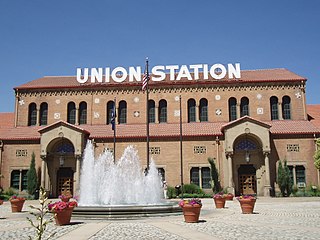
Union Station, also known as Ogden Union Station, is a train station in Ogden, Utah, United States, at the west end of Historic 25th Street, just south of the Ogden Central Station. Formerly the junction of the Union Pacific(UP) and Central Pacific (CP) railroads, its name reflects the common appellation of train stations whose tracks and facilities are shared by railway companies.

The Virginia Museum of Transportation (VMT) is a museum in Downtown Roanoke, Virginia, that is devoted to the topic of transportation.

Little Rock Union Station, also known as Mopac Station, is a train station in Little Rock, Arkansas, United States served by Amtrak, the national railroad passenger system.

The Lick Skillet Railroad Work Station Historic District is a historic district in Brinkley, Arkansas that was listed on the National Register of Historic Places in 1992.
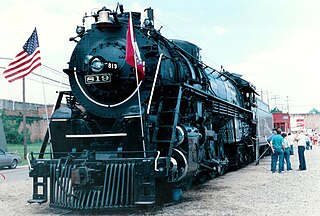
Cotton Belt 819 is a class "L-1" 4-8-4 "Northern" type steam locomotive and is also the official state locomotive of Arkansas. It was completed in 1943 and was the last engine built by the St. Louis Southwestern Railway, which was affectionately known as "The Cotton Belt Route" or simply "Cotton Belt". It was also the last locomotive built in Arkansas. It was restored to operating condition in 1986 and operated in excursion service until October 1993. As of 2023, the locomotive is now located at the Arkansas Railroad Museum, currently being cosmetically restored.

Arkansas Railroad Museum is located on Port Road in Pine Bluff, Arkansas at the former Cotton Belt (SSW) yard.
The El Paso and Southwestern Railroad began in 1888 as the Arizona and South Eastern Railroad, a short line serving copper mines in southern Arizona. Over the next few decades, it grew into a 1200-mile system that stretched from Tucumcari, New Mexico, southward to El Paso, Texas, and westward to Tucson, Arizona, with several branch lines, including one to Nacozari, Mexico. The railroad was bought by the Southern Pacific Railroad in 1924 and fully merged into its parent company in 1955. The EP&SW was a major link in the transcontinental route of the Golden State Limited.

James Postell Douglas was a soldier, politician, and businessman in the state of Texas. He is regarded as the founder of the Cotton Belt Route, a major railroad system connecting Texas and Arkansas north to St. Louis, Missouri.

The Cotton Belt Freight Depot is a former freight depot of the St. Louis Southwestern Railway in the Near North Riverfront neighborhood of St. Louis, Missouri. It was listed on the U.S. National Register of Historic Places in 2004 and named "Best Old Building" by the Riverfront Times, a weekly newspaper in St. Louis.

The St. Louis Southwestern Railway of Texas, operated the lines of its parent company, the St. Louis Southwestern Railway within the state of Texas. The St. Louis Southwestern, known by its nickname of "The Cotton Belt Route" or simply the Cotton Belt, was organized on January 12, 1891, although it had its origins in a rail line founded in 1871 in Tyler, Texas that eventually connected northeastern Texas to Arkansas and southeastern Missouri. Construction of the original Tyler Tap Railroad began in the summer of 1875, and the first 21 miles out of Tyler to Big Sandy, Texas were constructed by early October of 1887. The line became the Texas and St. Louis Railway, and was completed between Gatesville, Texas and Bird's Point, Missouri by August 12, 1883, creating a continuous 725-mile system. However, that line promptly went into receivership, and was purchased by the St. Louis, Arkansas and Texas Railway in 1886. The assets of that company were acquired out of foreclosure by the St. Louis-Southwestern Railway in 1891. The St. Louis Southwestern of Texas merged with the property of the Tyler Southeastern Railway on October 6, 1899. The property of the Texas and Louisiana Railway was acquired and merged on July 2, 1903.

Union Station is a former railroad station at East 4th Ave. and State St. in Pine Bluff, Jefferson County, Arkansas. The station was originally at the union of the Cotton Belt and Iron Mountain railroads, and now houses the Pine Bluff/Jefferson County Historical Society museum. It is a single-story brick building, with a hip roof whose long eaves are supported by iron columns and half-truss brackets. The station was built in 1906 by the Iron Mountain Railroad. It had been a stop on the St. Louis Southwestern's Lone Star (Memphis-Dallas), and also on the railway's St. Louis-Dallas trains.

Union Station is a building in Houston, Texas, in the United States. Dedicated on March 2, 1911, and formerly a hub of rail transportation, the building now serves as a cornerstone for Minute Maid Park. It is listed on the National Register of Historic Places, and has since been superseded by Houston's Amtrak station.
Originally incorporated as the Tyler Tap Railroad in 1871, the Texas and St. Louis Railway (“T&SL”) constructed a three-foot gauge railroad from Gatesville, Texas through Arkansas to Bird's Point, Missouri starting in 1875 and completing by 1883. One of the two longest narrow-gauge lines in the country, the railroad went into receivership in early 1884, and another railway had acquired its trackage by 1886.
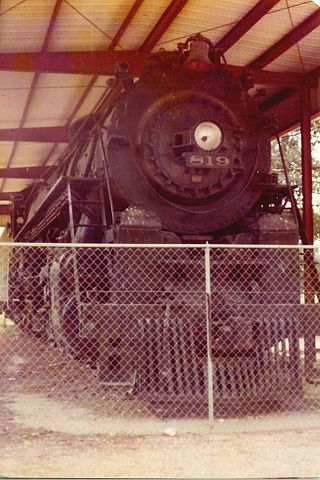
The Cotton Belt Class L-1 was a class of 20 4-8-4 "Northern" type steam locomotives that were built by the Baldwin Locomotive Works and the St. Louis Southwestern Railway at their own Pine Bluff Shops.



